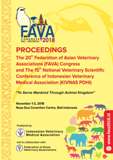SA-12 The Number of Dog Patients Infected with Companion Vector-Borne Diseases (CVBD) Treated at Klinik Hewan Jogja in 2017
Abstract
Companion Vector Borne Diseases (CVBD) are diseases transmitted by vectors which can cause fatal outcome for dogs [1]. CVBD frequently attack dogs and are easily transmitted from one dog to other dogs through vectors’, such as ticks, mosquitoes, or sand flies, bite [2,3]. Some of the most harmful CVBD that infect dogs via ticks’ bite are anaplasmosis, babesiosis, and ehrlichiosis [4]. These diseases cause decreased appetite, lethargy, fever, anemia, jaundice, emaciation, and finally death if not treated properly [5,6].
Blood parasites’ infections such as anaplasmosis, babesiosis, and ehrlichiosis are often found in the field. However, due to the limitations of diagnosis confirmation, they often go unnoticed. Despite the considerable number of cases in dogs, the exact incidence rate is not yet known. There is an global call to eradicate CVBD owing to the facts that they are dangerous and may cause economic losses, with the additional risk of being zoonotic [1,3].
Taking the importance of anaplasmosis, babesiosis, and ehrlichiosis in the veterinary science into account, seeing the scant amount of data regarding dog patients followed with the lack of attention on said diseases, it is then deemed necessary to properly diagnose those diseases in dogs brought into the clinic, particularly at Klinik Hewan Jogja. This research aims to identify the number of dog patients treated in Klinik Hewan Jogja infected with those particular sicknesses (CVBD).
The result of this study will provide a summary of CVBD treated at Klinik Hewan Jogja, which in turn, will raise awareness of the diseases and the significance of working together to tackle the issue. Furthermore, the result will also yield information for clients’ education to help them prevent the diseases.

